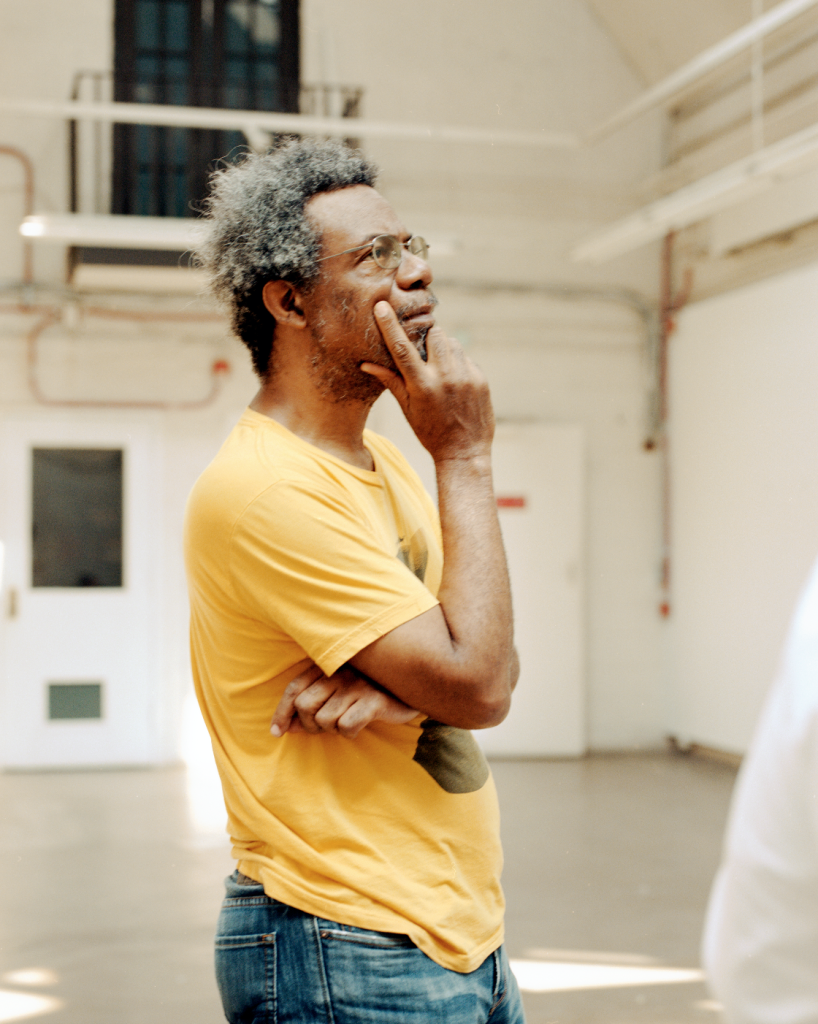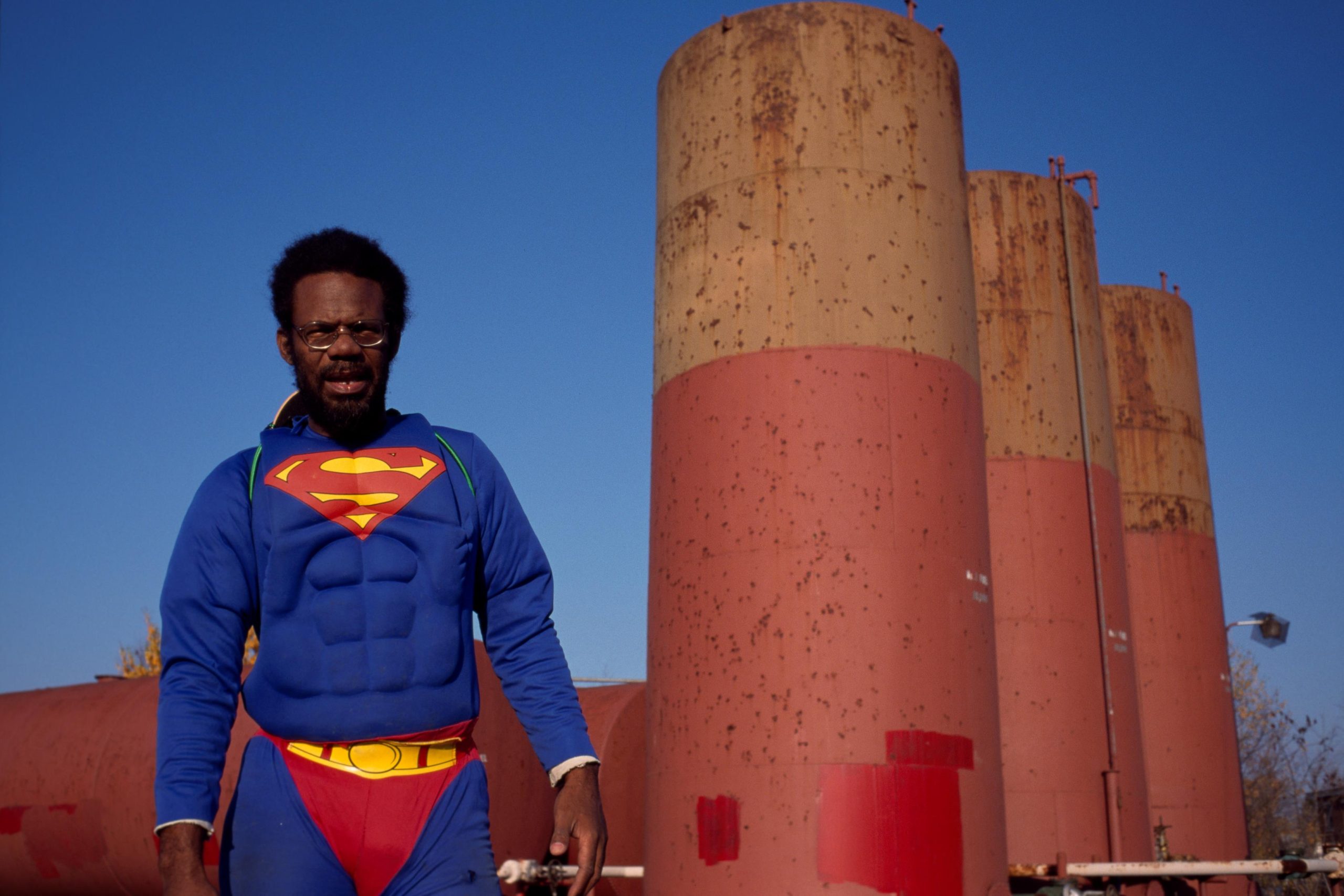As you produce work, it will become more personal for you and you will sometimes want to hold on to certain ideas. Part of my job is to help you move beyond what you think you know about performance and yourself. Therefore we may, at times, butt heads, things may get uncomfortable but trust is key, and part of learning is the ability to accept a challenge and transform it into growth.
Pope.L, Writing and Performing Syllabus, Fall 2021
The art world tends to pick some words, and use them until they’ve been ground from solid rock into sand, cheapening their use to the value of common backyard dirt, rather than the rare earth minerals they were intended for. ‘Brilliant’ has been ground into common dirt, which renders it fitting to describe the late Pope.L, who held the distinction of being both a rare earth mineral and common backyard dirt.
The first time I met Pope.L was over the phone. It was Fall 2020, my first term as a graduate student at the University of Chicago. We had a scheduled meeting over Zoom at noon, and eventually, he called me around one. He called me Michael when I answered, and I tried to correct him, but he called me Michael for the first six months I knew him. I don’t remember the details of that conversation, but what I do remember was a fierce introduction to his approach as a teacher, his methodical questioning, his playful games. Pope.L wasn’t known for his timeliness, but when he was there, he was THERE.
A few short months later, I began a defining feature of the Master of Fine Arts in Visual Arts program at the University of Chicago; the first year seminar taught by Pope.L, in which the cohort of eight is tasked with producing and acting an original adaptation of Hansel and Gretel. Most students hear rumors of the class in advance, but no one really knows what’s going to happen. In the context of a visual art program, most are simply puzzled that producing an adaptation on a centuries old fairytale is a program requirement.
Self-described as a fisherman of social absurdity and the friendliest Black artist in America, Pope.L, born William Pope Lancaster on June 28, 1955 and passed away December 23, 2023, was known primarily for his bold performances and multimedia artwork, including crawling through Manhattan in a superman costume, eating the Wall Street Journal, and chaining himself to a bank door with sausage links while wearing a skirt fashioned out of dollar bills. While lesser known for his teaching in the public sphere, his approach in the classroom was equally bold and provocative.
The consensus among former students is that during the Hansel and Gretel seminar, they didn’t know why they were doing it, their half-blind faith in the class driven partially by Hansel and Gretel alumni who encouraged current disciples to fully submit to the regiment and reflect on the experience afterward.
“Wrong and strong!” was Pope.L’s national anthem, he built a world for himself and lived by his own rules. He gave permission for us to fail, required us to fail, and insisted we put forth a complete effort while failing.
A certain flavor of timidness wafts over people attempting to act who don’t usually act. Pope.L required a shedding of this timidness and asked for a complete effort. He knew doing anything for the first time would never be good, thus embarrassment wasn’t a possibility. He saw repetition as critical in the pursuit of excellence, and drilled repetition into his students who attempted to alter too much of a performance or artwork.
In the preparation to write our own version of Hansel and Gretel, we never read the original version by the Brothers Grimm. We read some other Grimm tales, and we read some adaptations of “Hansel and Gretel,” but Pope.L insisted we already had versions of the tale inside us, thus it wasn’t necessary to read the original. The point was to construct a version of the tale that fit our own unique social and temporal circumstances, and he believed reading the original would cloud our judgment when constructing a new version of the tale.
The play was divided into eight scenes, we were each tasked with writing one scene. During the initial draft, we weren’t allowed to consult each other on how we planned on writing our scenes, which resulted in eight radically different creative directions. With Pope.L’s guidance, we merged these eight directions into one. The process was messy, a controlled chaos by design, and through collectively writing a version of “Hansel and Gretel,” we found a way of relating to each other, whether we knew it or not.
Some people think they need excavators when they could do with a shovel, or perhaps even their hands. The “Wrong and Strong!” anthem encouraged rawness, openness, and encouraged, perhaps even demanded, using whatever tools at your disposal to build a castle. No tool was inadequate, whether it be a sheet of cardboard, a rubber ball, or a sharpie, using simple tools or no tools at all was considered better than using expensive tools in a middling manner.

A relentless proponent of the drafting process, Pope.L often prescribed repetition. Whatever the assignment, whether a ten-minute performance or a seemingly simple exercise, he favored a damning approach to getting it right. His approach often seemed more closely to that of shooting free throws for hours or a session at the driving range than other university classes.
“What is writing?” he asked me once. I responded with silence because I thought it was a trick question. “Rewriting,” he replied to himself. He never asked trick questions, he only asked the simple questions, which were the hardest.
Pope.L cultivated structures in which every role held importance. To Pope.L, the Hansel and Gretel extension cord manager was equally important as the stage manager. To some, the stage manager would appear more important than the extension cord manager, but both had a job to do, and both had to do it well in service of the whole. And yes, there really was an extension cord manager.
“When I got out of school, the first thing he asked me was if I had a job…Can you pay your bills? That’s actually the most important thing right now, right,” said Devin T. Mays, artist and educator, “Can you feed yourself and can you offer yourself shelter? You know what I’m saying? That was the most important thing. And he felt relieved when I was like, I do.”
Above all art-making activities, Pope.L stressed taking care of oneself. During interviews for prospective graduate students, Pope.L would often ask candidates if they had a way of supporting themselves during graduate school. As rigorous as Pope.L was, it was important that his students took care of themselves. He ultimately saw art as a luxury and having a roof over one’s head, paying one’s bills, were more important than making art.
Pope.L articulated advice you didn’t know you needed, and articulated things I hadn’t previously considered to be ‘advice.’ His commitment to making and thinking about art in relation to how that art came to be in the real world led to strong tunnels shaped with concrete forms and steel beams, his thoughts held shape. Occasionally, this advice would appear like a riddle, other times it would be delivered as an observation about something in the real world, as it related to the artwork or performance under review.
Madeline Gallucci, artist and arts administrator, recalled a time when Pope.L described a sculpture of hers, “that it reminded him of if the sculpture had sound, it would be like the sound of a Berlin nightclub where the ceiling is too low and the music isn’t quite loud enough, so you can hear everyone shuffling.”
Talking about the work was a form of revision and repetition for Pope.L, continually revisiting a problem until all the cobwebs dissipated was his bread and butter. He allowed us to see outside of the work, to remind us of the context in which we were making artwork, which was the world at large, not the art world.
“If your only relationship to that thing is this one thing that you kind of continuously do with it, or do to it or whatever, then how do you ever have a sense of kind of, like, what that thing is? You know what I mean? How do you ever have a sense of how big it can be or how small it is? You don’t have a sense of scale,” said Mays.
His performance background and visual art teachings were largely the same, often he would grill me about background information on a sculpture, who a particular character (sculpture) was supposed to represent, what their name was. I didn’t always know the answer to these questions, and he knew I didn’t know the answer when he asked it. He reminded me the audience didn’t need to have the answer, but I needed to have it, much like an actor who thinks about who the character’s parents were. Everything needed a reason. The reason didn’t necessarily need to make sense, but one needed to be there.
During Hansel and Gretel, I was cast as Gretel for a scene, and in that scene Gretel was trapped in a cage while the witch fattened up Hansel for eating. Pope.L found my acting job, in terms of portraying fear and repulsion, to leave something to be desired. As homework, he recommended I watch some force-feeding fetish videos, and to consider how those videos made me feel, and then incorporate those feelings into my interpretation of Gretel.
The mythos of Pope.L’s Hansel and Gretel was the Kool-Aid committed students drank. Pope.L didn’t teach this class, he led it, and he led by example. He treated the class as if he were taking it himself, he thought about the class day and night, calling and emailing us students at all hours of the day with suggestions and recommendations. His commitment to the class drove us to wear Hansel and Gretel’s robes, and to dig Pope.L’s tunnels with him. The class and the students became a singular entity, which occasionally led to tense moments, but one doesn’t grow in comfort.
I watched those force-feeding fetish videos, and practiced my delivery of Gretel while walking in laps around the Guaranteed Rate Field Parking Lot G on cold February days. Instructing a student to watch force-feeding fetish videos for research is admittedly unorthodox, one that most would never do for fear of backlash, if they even managed to think of it, but commitment to excellence demands unorthodoxy, it demands wrong, and it demands strong.

About the author: Miles MacClure is an artist and occasional writer based in Chicago.



